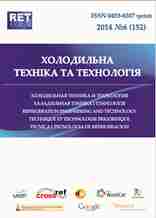THE NANOPARTICLES EFFECT ON THE LIQUID-LIQUID PHASE EQUILIBRIUM PARAMETERS. PART 1.
DOI:
https://doi.org/10.15673/0453-8307.6/2014.30693Keywords:
layering curve – Nanoparticle – Concentration – Nanofluid – ExperimentAbstract
Nanofluids (NF), i.e. fluids embedded with nanostructured materials, exhibit greatly enhanced thermal properties. The exploitation of NF phenomena is a tool for creation of new class of efficient working and heat transfer media for wide range of technological application. It is obvious that nanoparticles have an influence on thermophysical properties. The influence depends on nature of the NF, its size and concentrations and thermodynamical parameters. For today, the viscosity and heat conductivity are most investigated properties of the NF. On the other hand, the influence of the nanoparticles on the surface tension, phase equilibrium liquid-liquid (LLE), vapor-liquid (VLE), solid-vapor (SVE) has not been adequately investigated.The results ofstudies of the effectof nanoparticles(TiO2andAl2O3witha mass concentration of0.01% and0.017%in the sample, respectively) onthe parameters ofthe phase equilibriumliquid-liquidsystemsnitrobenzene-heptane andH2O-phenol-isopropanol are given in the article. The experimental setup for the study of the coexistence curves in a wide temperature range was created as part of the study. The experimental setup, methodology of the experiment are outlined. The tables of the experimental data are presented. Conclusion about the effect of nanoparticles on the parameters of the coexistence curve are made according to the results of studies. The presence of small amounts of TiO2 nanoparticle sin heptane and Al2O3in isopropanol reduced the separation temperature. This effect should be considered as positive. Because it will contribute to a better entrainment of compressor oil impurities from the evaporator.The composition of the solution in the upper critical point of the coexistence curve practically are unchanged.
References
REFERENCES
Bi SS, Shi L, Zhang L.L. Application of nanopar-ticles in domestic refrigerators Appl. Therm. Eng. 2008; 28:1834–43. DOI:10.1016/j.applthermaleng.2007.11.018
Kedzierski M.A. Effect of CuO Nanoparticle Concentration on R134a-Lubricant Pool Boiling Heat Transfer // Micro-Nanoscale Heat Transfer Interna-tional Conference. January 6–9, 2008: Proceedings Taiwan – N. Y. – P.1–8. DOI: 10.1115/1.3072926
José M. S. Fonseca, Ralf Dohrn , Stephanie Peper High-Pressure Fluid-Phase Equilibria: Experi-mental Methods and Systems Investigated (2005-2008)// Fluid Phase Equilibria (2010).
DOI: 10.1016/j.fluid.2010.09.017


